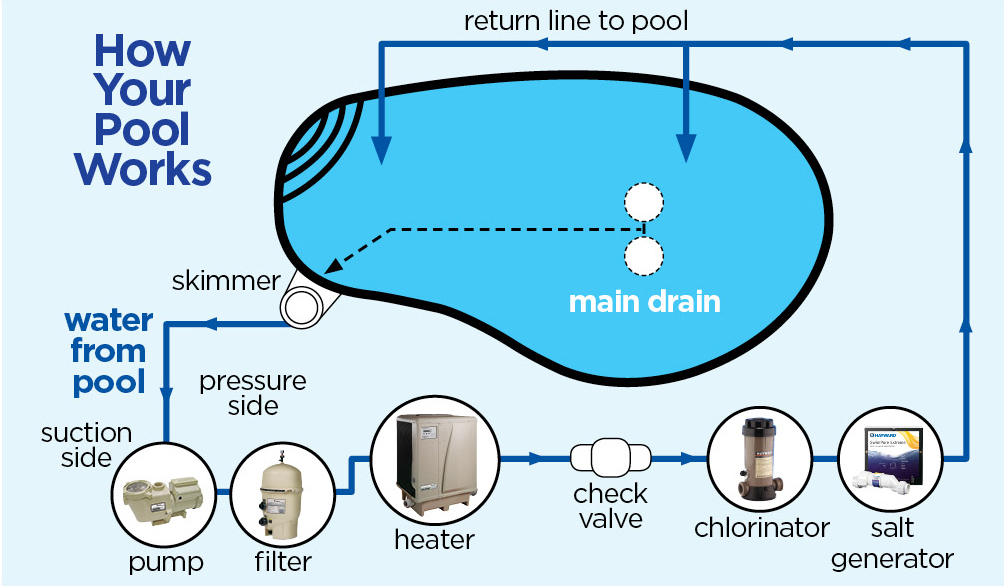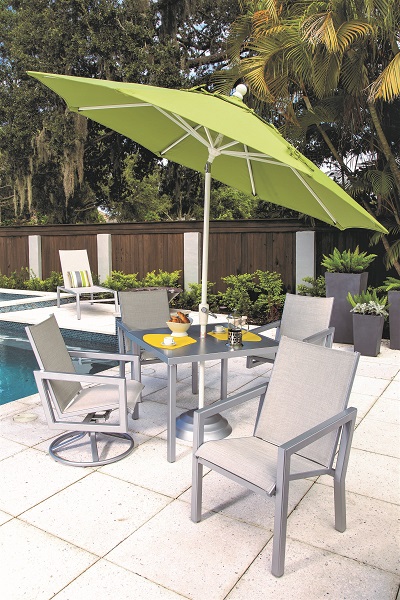All pools have the same main components that keep the water moving and clean – a pump, filter, drains and skimmer, return lines and vacuum. Each of these components come in different types and models that vary based on the pool’s size, location and owner preference. There are also additional features that you can add to your pool to enhance it even more, such as a heater, in-line chlorinator or salt generator.
We’ll walk you through each of the main components as well as the additional features so you can see how they all work together to provide you with the best pool experience.
Required Equipment
Pump
The most important piece of equipment in your swimming pool is the pump; it is the heart of the system. The pump moves water through the drains, pipes and other equipment in your pool. Without a pump you cannot filter, heat or clean your water. Certain methods of adding chemicals also rely on the pump to distribute treatments to the pool. Water enters the pump through the main drain and the skimmer(s), and there is a basket that prevents large debris from entering it. A pump also runs most automatic cleaners by either drawing in water or pushing it out, and they supply power for additional water features.
Filter
A filter is the main way of removing debris from pool water. There are 3 types of pool filters: sand, cartridge and DE. Each filter has different cleaning capacities. All pools require a filter of some kind, even above-ground. Water should flow from your pump directly into your filter. After entering the filter, the water either returns to your pool or goes through other equipment like heaters. Filters need to be cleaned on a consistent basis to maintain their effectiveness.
Drains and Skimmer
The main drain is the primary way that water is drawn from your pool into the pump and filter. The main drain is located on the bottom of the pool in the deepest part. Most pools have one, but larger pools may have multiple main drains. Main drains must be protected by an approved cover. Water is also pulled into the pump through one or more skimmers, located on the waterline. Because they are on the surface, they use baskets to catch floating debris like leaves. Some models have a weir door that helps to collect the debris and keep it from returning to the pool. Skimmers and main drains use PVC pipe to carry water to the pump.
Return Lines
These pipes take water that has been filtered, and in some cases heated or chemically treated, and pushes it back into the pool. The return lines have inlets or jets around the top of the pool in various places. Some inlets have openings that allow you to control which direction the water flows as it returns to the pool. Return lines can also supply water to a waterfall or other features in the pool. In some cases, return lines are plumbed into the floor, creating a cleaning system that pushes debris toward the main drain.
Vacuum
Every pool needs a vacuum to clean debris that has settled on the bottom. Whether you have a manual suction-side vacuum or an automatic cleaner, this piece of equipment is invaluable. Some cleaners use suction and others use pressure. Certain cleaner models need a dedicated booster pump to run. Robotic cleaners have their own suction systems and run on electricity independent of your pump.

Optional Equipment
Heater
A pool heater heats the water to provide a more comfortable swimming environment and to extend the swimming season. Water enters the heater after the pump and filter and then returns to the pool via the return lines. The best place for return lines is the floor of the pool because heat rises. This will maximize the effectiveness of your heater. Heaters are also used for spas and hot tubs. There are 3 main heater types: gas, electric pumps and solar heating systems.
In-line Chlorinators
Chlorine is the most widely used chemical to sanitize pools and kill germs, viruses and bacteria. Some pools have a floating chlorinator that dispenses the chlorine to the pool. This is not part of your pool’s plumbing system. Other chlorinators are part of your pool’s plumbing, adding chlorine directly to plumbing lines. Both methods add chlorine by way of erosion. A chlorinator will be plumbed into your equipment after the pump, filter and heater (if there is one). This is to prevent the chemicals from eroding the metal parts and pieces of this equipment. Once the volume of the pool has diluted the chemicals, it is safe to return to the system via the pump.
Salt Generators
Certain pools use a salt generator as an alternative to chlorine. This generator is plumbed in a similar way to a chlorinator: after the pump, filter and heater. A salt generator is a coated plate that is electrically charged. This creates a chemical reaction that converts salt to chlorine that sanitizes the pool. This eliminates some of the work of adding chemicals to your pool, but you should check your pool chemistry often and follow the ABC’s of pool care.
A pool provides endless amounts of fun with family and friends in your backyard. Not all pool owners, however, know what makes their pool a reality. Understanding how your pool works is important because it will help you maintain it better!
Share This Post

